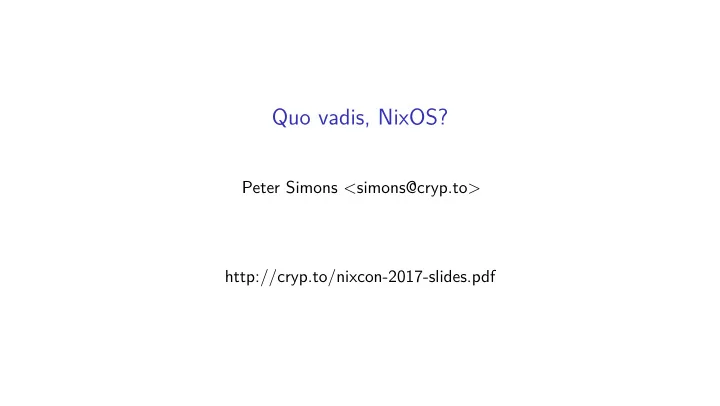

Quo vadis, NixOS? Peter Simons <simons@cryp.to> http://cryp.to/nixcon-2017-slides.pdf
Commercially Successful Distributions Offer . . . ◮ products that fit the user’s requirements: ◮ desktop vs. server ◮ real hardware vs. virtualization ◮ small footprint vs. feature-rich ◮ stability ◮ security ◮ transparency
Learning from Others ◮ SUSE Linux has been around since 1994 and it’s commercially successful. ◮ The free distribution openSUSE operates separately since 2005. ◮ Tumbleweed ≈ nixos-unstable ◮ Leap ≈ nixos-yy.mm ◮ SUSE Linux Enterprise has no NixOS equivalent.
Development Process in openSUSE ◮ All contributors use https://build.opensuse.org/ (Open Build System). - entry barrier + everyone has an unique handle and an e-mail address + tailor-made features to support the workflow ◮ OBS contains a set of (hierarchically named) projects: openSUSE:Factory openSUSE:Leap:42.2 devel:languages:python home:psimons:tmp
Development Process in openSUSE ◮ A project consists of a set of packages. ◮ Every project defines build targets . These are references to other projects, which are used for dependency resolution. ◮ Every package in a project is compiled for every target. ◮ The shape of an openSUSE installation is defined by the the set of projects the system subscribes to: # zypper repos | Alias | Name | Enabled | GPG Check | +--------------+----------------------+---------+-----------+ | home_psimons | psimons home project | Yes | (r ) Yes | | non-oss | NON-OSS | Yes | (r ) Yes | | oss | OSS | Yes | (r ) Yes |
Developing openSUSE:Factory (Tumbleweed) 1. Branch editors/emacs into your home project. 2. Modify your local copy. 3. Create submit request to push your version back upstream. 4. Owner of editors/emacs accepts (or denies) that request. 5. Owner of editors/emacs then creates submit request for openSUSE:Factory . 6. Review team accepts (or denies) that request.
Package Rings ◮ ring 0: 106 packages required for bootstrapping ◮ ring 1: +1361 packages required for a minimal-X DVD ◮ ring 2: +1108 packages required for a complete DVD
Developing Leap ◮ A set of packages is collected from various sources (like openSUSE:Factory ), integration tested extensively, and released. ◮ Submit requests can be accepted by the release managers: ◮ security issues ◮ bug fixes But: ◮ no version updates ◮ no user-visible change in behavior ◮ Changes are expected to refer to a CVE or Bugzilla issue for reference. ◮ Every change comes with a high-level description of its purpose.
Lessons to Be Learned 1. A distribution’s core task is integration testing . 2. Peer review all changes. 3. Defining (and deploying) variants can be easy. 4. Have clear ownership of packages and products. 5. Provide integrated services for development, testing, and support.
Opportunities to Improve NixOS 1. Make hydra.nixos.org accessible to the community. 2. Make Nixpkgs as modular as possible. 3. Prevent contributors from committing broken code or breaking existing code. 4. Every package, test, or NixOS module must have an owner. 5. Provide explicit project leadership.
Recommend
More recommend